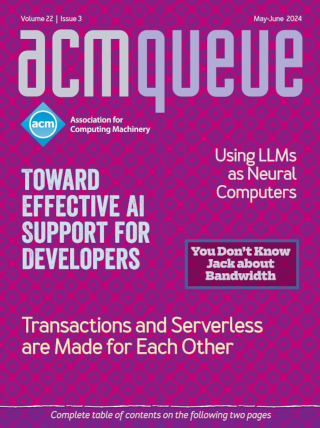
A Conversation with Tim Bray:
Searching for ways to tame the world’s vast stores of information.
Tim Bray’s Waterloo was no crushing defeat, but rather the beginning of his success as one of the conquerors of search engine technology and XML. In 1986, after working in software at DEC and GTE, he took a job at the University of Waterloo in Ontario, Canada, where he managed the New Oxford English Dictionary Project, an ambitious research endeavor to bring the venerable Oxford English Dictionary into the computer age.
A Passage to India:
Pitfalls that the outsourcing vendor forgot to mention
Most American IT employees take a dim view of offshore outsourcing. It’s considered unpatriotic and it drains valuable intellectual capital and jobs from the United States to destinations such as India or China. Online discussion forums on sites such as isyourjobgoingoffshore.com are headlined with titles such as “How will you cope?” and “Is your career in danger?” A cover story in BusinessWeek magazine a couple of years ago summed up the angst most people suffer when faced with offshoring: “Is your job next?”
Kode Vicious Unleashed:
Koding konundrums driving you nuts? Ko-workers making you krazy? Not to worry, Kode Vicious has you covered.
Dear KV, My officemate writes methods that are 1,000 lines long and claims they are easier to understand than if they were broken down into a smaller set of methods. How can we convince him his code is a maintenance nightmare?
Orchestrating an Automated Test Lab:
Composing a score can help us manage the complexity of testing distributed apps.
Networking and the Internet are encouraging increasing levels of interaction and collaboration between people and their software. Whether users are playing games or composing legal documents, their applications need to manage the complex interleaving of actions from multiple machines over potentially unreliable connections. As an example, Silicon Chalk is a distributed application designed to enhance the in-class experience of instructors and students. Its distributed nature requires that we test with multiple machines. Manual testing is too tedious, expensive, and inconsistent to be effective. While automating our testing, however, we have found it very labor intensive to maintain a set of scripts describing each machine’s portion of a given test. Maintainability suffers because the test description is spread over several files.
Quality Assurance: Much More than Testing:
Good QA is not only about technology, but also methods and approaches.
Quality assurance isn’t just testing, or analysis, or wishful thinking. Although it can be boring, difficult, and tedious, QA is nonetheless essential. Ensuring that a system will work when delivered requires much planning and discipline. Convincing others that the system will function properly requires even more careful and thoughtful effort. QA is performed through all stages of the project, not just slapped on at the end. It is a way of life.
Sifting Through the Software Sandbox: SCM Meets QA:
Source control—it’s not just for tracking changes anymore.
Thanks to modern SCM (software configuration management) systems, when developers work on a codeline they leave behind a trail of clues that can reveal what parts of the code have been modified, when, how, and by whom. From the perspective of QA (quality assurance) and test engineers, is this all just “data,” or is there useful information that can improve the test coverage and overall quality of a product?
Too Darned Big to Test:
Testing large systems is a daunting task, but there are steps we can take to ease the pain.
The increasing size and complexity of software, coupled with concurrency and distributed systems, has made apparent the ineffectiveness of using only handcrafted tests. The misuse of code coverage and avoidance of random testing has exacerbated the problem. We must start again, beginning with good design (including dependency analysis), good static checking (including model property checking), and good unit testing (including good input selection). Code coverage can help select and prioritize tests to make you more efficient, as can the all-pairs technique for controlling the number of configurations. Finally, testers can use models to generate test coverage and good stochastic tests, and to act as test oracles.
Traipsing Through the QA Tools Desert:
Who’s really to blame for buggy code?
The Jeremiahs of the software world are out there lamenting, “Software is buggy and insecure!” Like the biblical prophet who bemoaned the wickedness of his people, these malcontents tell us we must repent and change our ways. But as someone involved in building commercial software, I’m thinking to myself, “I don’t need to repent. I do care about software quality.” Even so, I know that I have transgressed. I have shipped software that has bugs in it. Why did I do it? Why can’t I ship perfect software all the time?





